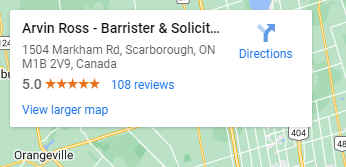Being charged with a crime in Canada is a serious matter. However, there are various classifications that can affect the severity of penalties a person may face. One of these classifications is whether an offence is designated as absolute liability, strict liability, or mens rea. These categories dictate whether the courts believe criminal intent was present.
What Are Canada’s Three Standards of Liability for Offences?
While criminal intent is a significant element of an offence in Canada, it is not the only consideration. The standard of liability under which an act falls will also dictate the defences that the accused can employ to prove their innocence.
What Is Absolute Liability?
An absolute liability violation is a standard of liability where the Crown Attorney is not required to prove that a person had criminal intent. They need only prove that an act happened beyond a reasonable doubt. The defendant is not entitled to a defence of necessity, accident, or due diligence.
This may sound like the deck is stacked against a defendant, but the one positive aspect of these charges is that jail time is not a possibility. Heavy fines are possible.
What Is Strict Liability?
Strict liability violations also do not require that the Crown Attorney prove criminal intent. It’s enough to simply show the courts beyond a reasonable doubt that an act occurred. However, the defendant is entitled to defences such as mistake of fact and due diligence.
While having additional defence options is good, strict liability crimes can result in fines and jail time.
What Is Full Mens Rea?
When the Crown Attorney can prove criminal intent, the mens rea element is established, hence the accused may face a conviction. This means that a person had intent, knowledge, or engaged in reckless acts. Proving intent can be done by meeting evidentiary standards.
When mens rea is proven, the penalties can be severe. Many people are serving life in prison because the courts believed criminal intent was present during their alleged crimes.
What Are Examples of Different Types of Crime in Canada?
The difference between absolute liability, strict liability, and mens rea in Canada may seem complicated to those outside of the legal field. The following examples provide some insight into the types of crimes that may fall under each liability standard:
- Absolute liability crimes
- Failing to stop at a stop sign
- No valid insurance card
- Dumping industrial waste
- Employers failing to provide required safety equipment
- Strict liability crimes
- Careless driving
- Selling food deceptively
- Emitting certain contaminants
- Misleading advertising
- Mens rea crimes
- Embezzlement
- Lying to a police officer
- Misleading information on tax forms
- Murder
What If You’re Charged With a Crime?
A lack of criminal intent is often a mitigating factor when it comes to charges laid in court. However, this lack of intent does not mean you won’t face serious consequences. In fact, defendants can end up in prison even if they never intended to commit a crime.
As such, your first step should be to remain silent. You don’t have to speak to the police. In many instances, you may admit to an absolute or strict liability crime while trying to explain that you had no criminal intent. Instead, you should immediately contact a criminal defence lawyer.
 647-503-5251
647-503-5251






